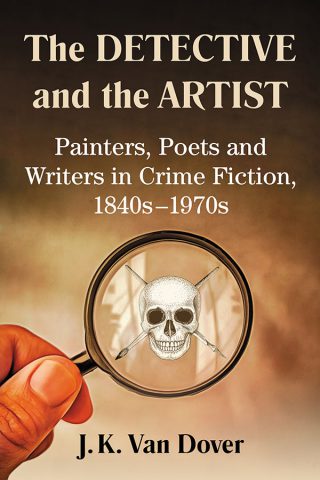In the majority of crime fiction, there exists a relationship between the main characters. “The Detective and the Artist, then, concentrates upon the role played by poets, novelists, and painters in the detective story. These specialists in the production of works of aesthetic imagination are set in radical contrast to the defining figure of the genre, the detective, who is a specialist in moral inquiry. They produce through imagination; he or she investigates through methodical inquiry.”
 Says author Van Dover, who taught in the English Department of Lincoln University for 38 years and published extensively on detective fiction. Here he has compiled some of his expertise on artists as they appear in detective fiction.
Says author Van Dover, who taught in the English Department of Lincoln University for 38 years and published extensively on detective fiction. Here he has compiled some of his expertise on artists as they appear in detective fiction.
As he argues, both deduction, crime solving and the creative act of finishing a painting or a sculpture, have one main similarity: they all require some access to “art.” And not only are certain murderers and other criminals extremely innovative, smart and artful about their deeds, it seems that each time a fictional crime is written, a contest of artfulness in both covering it up or resolving it is; namely between the criminal and the detective.
Depending on the time of publication, these methods varied, as he points out. Dozens, if not hundreds of works from all the eras of detective fiction are closely analyzed here. What the title offers, is insight into the strategies of Dupin, Holmes, Poirot, Marple, Clancy, Father Brown, Spade and Marlowe and others as well as their respective criminal counterparts. As it turns out, special appreciation of the arts – like collecting rare books, producing sculpture, paintings or music – as traits of the detective character are rather unusual; particularly for the hard-boiled faction that more or less despises the arts entirely, according to Van Dover.
Apart from the artful planning and obstruction of the crime, he also rarely sees villains obsessed with art. “These artist-villains usually commit their crimes for the usual reasons and with the usual devices, though they might exercise some superior imagination in the application of those devices. … Nor do they generally talk about art; they are preoccupied with the pragmatic concerns that drive them to crime…”
Special emphasis is given to popular authors like Arthur Conan Doyle, Arthur Morrison, G.K. Chesterton, R. Austin Freeman, Dorothy Sawyers, Agatha Christie, P.D. James and Ross Macdonald, who receive several pages of analysis, while many more crime fiction authors – in their respective treatment of artists in their fiction – are mentioned rather briefly.
In the process, we learn about the role of the victim, as he also could be an artist, but rarely is, or rather, hardly ever is the only victim in a case. From a critical or aesthetic point of view, more often the “villain is a creator; the detective is a critic; the victim is the object d’art. The corpse and its epiphenomena are composed by the villain and are appreciated, critiqued, and understood by the detective. It is a carefully crafted object.”
Nevertheless, as storytelling is an art form too, the detective who at the end of the investigation uncovers misdemeanor and the criminal must have a convincing story ready that explains what happened when and why. This, however, is mostly moral work and not one of purely aesthetic value, argues Van Dover. Hardly any detective will identify themself as an artist, as they “… are not driven to produce art.” The production of art or a particularly artistic/creative approach to crimes is mostly alien to the investigators while they are able to identify patterns and methods.
What sounds like a discrepancy at first, is really a different approach to understanding situations and circumstances. “The artist pursues beauty; the detective pursues truth. … His art is an art of knowing.”
After all, it seems that hardly ever in the fiction surveyed here, are artists particularly successful criminals either. “Great artists fail as criminals because they lack the critical detachment. They may be genuinely creative, but their creativity seems to blind them to the insights that critical intelligence provides.”
The Detective and the Artist is actually very specific and has a philosophical touch, since it concentrates on the creative efforts of mostly the villains. Subsumed briefly, the emphasis of the book is on distinctive ways of expression, given that committing a crime or solving it calls for completely dissimilar approaches of the characters in the novels. Van Dover easily connects various artists and detectives from different eras while juxtaposing particular cases with artists involved. This, actually, is one of the best features of the book, as recalling hundreds of novels and fictional characters/artists and acknowledging their unique roles is very impressive.
Review by Dr. A. Ebert © 2019
J.K. Van Dover. The Detective and the Artist: Painters, Poets and Writers in Crime Fiction, 1840s – 1970s. McFarland, 2019, 196 p.
